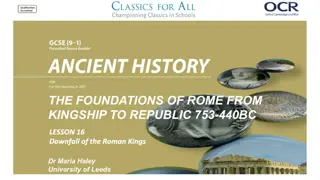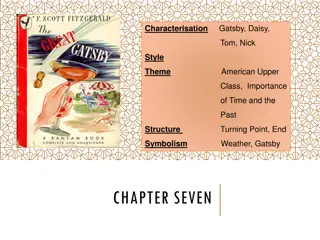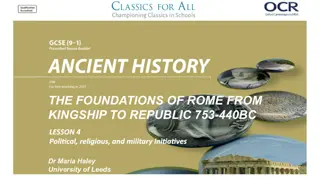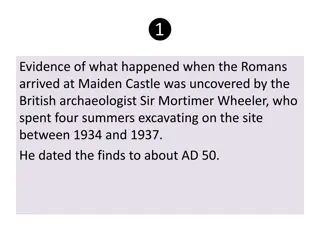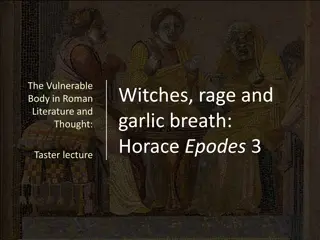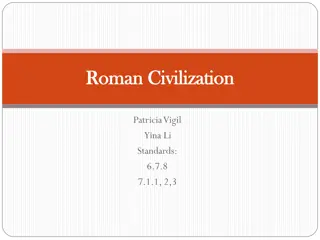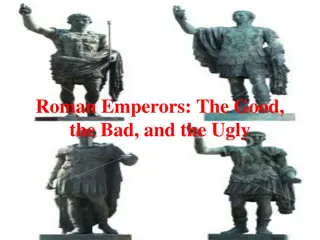Comparing Apotheosis in Roman Culture: Trimalchio and the Julio-Claudians
Tracing the concept of apotheosis in Roman culture, this content explores the contrasting deification processes of Trimalchio and the Julio-Claudian emperors, focusing on the visual representations and societal perceptions of divinity. From Trimalchio's extravagant depiction to the imperial cult of Augustus and Claudius, the evolution of deification ceremonies reflects the political and religious dynamics of ancient Rome, shaping public worship and posthumous honors.
Download Presentation

Please find below an Image/Link to download the presentation.
The content on the website is provided AS IS for your information and personal use only. It may not be sold, licensed, or shared on other websites without obtaining consent from the author.If you encounter any issues during the download, it is possible that the publisher has removed the file from their server.
You are allowed to download the files provided on this website for personal or commercial use, subject to the condition that they are used lawfully. All files are the property of their respective owners.
The content on the website is provided AS IS for your information and personal use only. It may not be sold, licensed, or shared on other websites without obtaining consent from the author.
E N D
Presentation Transcript
The Apotheosis of Trimalchio Compared to the Julio-Claudians Griffin Fleischaker
Satyricon 29.3-6 Erat autem venalicium cum titulis pictum, et ipse Trimalchio capillatus caduceum tenebat Minervaque ducente Romam intrabat. Hinc quemadmodum ratiocinari didicisset, denique dispensator factus esset, omnia diligenter curiosus pictor cum inscriptione reddiderat. In deficiente vero iam porticu levatum mento in tribunal excelsum Mercurius rapiebat. Praesto erat Fortuna cornu abundanti copiosa et tres Parcae aurea pensa torquentes.
The Apotheosis of Augustus Augustales: Imperial cult to the deified Augustus formed in the 1stcentury BCE They worshipped a deified Augustus in the provinces away from Rome during his life. Gemma Augustea: reign of Tiberius Image source: Kunsthistorisches Museum, Vienna
The Apotheosis of Augustus (cont.) Tractatum etiam in senatu an, quia condidisset imperium, Romulus vocaretur; sed sanctius et reverentius visum est nomen Augusti, ut scilicet iam tum, dum colit terras, ipso nomine et titulo consecraretur It was also discussed in the senate if he should not be called Romulus, because he had established the empire; but the name of Augustus was deemed more holy and venerable, in order that, while he still lived on earth, he might be given a name and a title which raised him to the rank of a deity. Florus, Epitome Rerum Romanorum, 2.34.66
The Apotheosis of Claudius Ad summam, tria verba cito dicat et servum me ducat. Hunc deum quis colet? To sum it up, have him say three words quickly and have him lead me as a slave. Who will worship this god? Seneca, Apocolocyntosis 11.3 Trimalchio is depicted as the opposite of this Caelestesque honores Claudio decernuntur et funeris sollemne perinde ac divo Augusto celebratur And the heavenly honors are decreed to Claudius and this solemn funeral is celebrated in the way of the divine Augustus Tacitus, Annales, 12.69 The Deification of Claudius Image source: The Vatican Museums, Vatican City
Bibliography Battistella , C. 2006. Trimalchio's 'Kidnapping': Mythological and Iconographic Memory in Petr. Sat. 29.5. Mnemosyne 59. 427-33. Bodel, J. 2016. Death and Social Death in Ancient Rome. In J. Bodel and W. Scheidel (eds.), On Human Bondage: After Slavery and Social Death (Malden, MA), 81-108. Fishwick, D. 1992. On the Temple of Divus Augustus. Phoenix: 232-55. Fishwick, D. 2002. The Deification of Claudius. The Classical Quarterly 52: 341-9. Hackworth Petersen, L. 2015. Arte Plebea and Non-elite Roman Art. In B.A. Borg (ed.), A Companion to Roman Art (Malden, MA), 214-30. H bner, W. 2003. Trimalchio Mercurialis. In D. Accorinti and P. Chuvin (eds.), Des G ants Dionysos: M langes offerts Francis Vian (Alessandria), 75-94. Neumann, G. 1999. Petron, Satyrica c. 29, 5 , W rzburger Jahrb cher f r die Altertumswissenschaft 23: 115- 22. Paschalis, M. 2009. Seneca s Apocolocyntosis and Petronius Satyricon. In M. Paschalis et al. (eds.), Readers and Writers in the Ancient Novel (Groningen), 1012: 102-14. Zanker, P. 1990. The Power of Images in the Age of Augustus. Ann Arbor: University of Michigan Press.
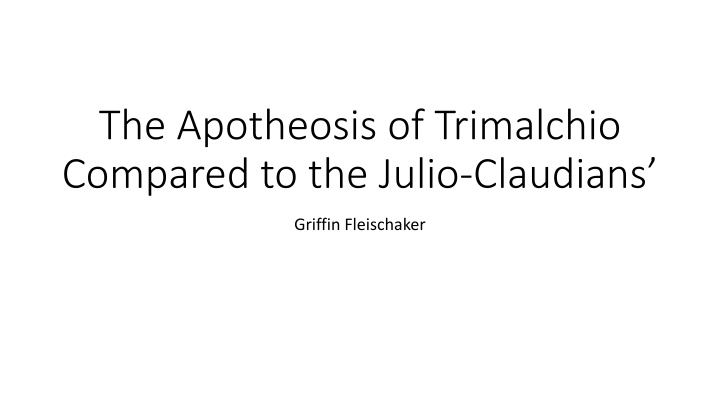

![Read⚡ebook✔[PDF] Blood of the Provinces: The Roman Auxila and the Making of Pro](/thumb/20539/read-ebook-pdf-blood-of-the-provinces-the-roman-auxila-and-the-making-of-pro.jpg)


